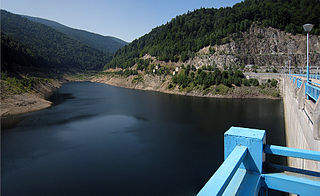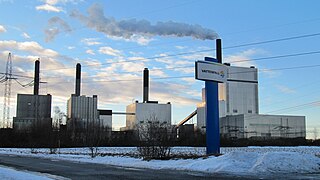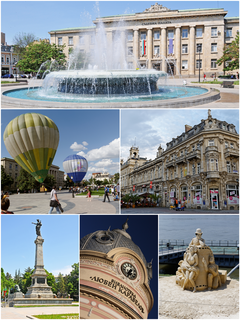
The economy of Bulgaria functions on the principles of the free market, having a large private sector and a smaller public one. Bulgaria is an industrialised upper-middle-income country according to the World Bank, and is a member of the European Union (EU), World Trade Organization (WTO), Organization for Security and Co-operation in Europe (OSCE) and Organization of the Black Sea Economic Cooperation (BSEC). The Bulgarian economy has experienced rapid growth in recent years reaching estimated gross domestic product (GDP) of $152 billion, GDP per capita of $21,498, and average monthly gross salary of 1123 leva. The national currency is the lev, pegged to the euro at a rate of 1.95583 leva for 1 euro. The lev is the strongest and most stable currency in Eastern Europe.

Hydropower or water power is power derived from the energy of falling water or fast running water, which may be harnessed for useful purposes. Since ancient times, hydropower from many kinds of watermills has been used as a renewable energy source for irrigation and the operation of various mechanical devices, such as gristmills, sawmills, textile mills, trip hammers, dock cranes, domestic lifts, and ore mills. A trompe, which produces compressed air from falling water, is sometimes used to power other machinery at a distance.

The Bełchatów Power Station is the world's largest lignite-fired power station situated near Bełchatów in Łódź Voivodeship, Poland. It is the largest thermal power station in Europe, and second largest fossil-fuel power station in the world. It produces 27–28 TWh of electricity per year, or 20% of the total power generation in Poland. The power station is owned and operated by PGE GIEK Oddział Elektrownia Bełchatów, a subsidiary of Polska Grupa Energetyczna.

Rogun Dam is an embankment dam under construction on the Vakhsh River in southern Tajikistan. The dam is situated 110 km from Dushanbe. It is one of the planned hydroelectric power plants of Vakhsh Cascade.

Bulgaria's first commercial nuclear reactor began operation in 1974. The Kozloduy NPP operates two pressurized water reactors with a total output of 1906 MW. Construction of the Belene Nuclear Power Plant was officially terminated in March 2012, and a thermal powerplant was supposed to be built on the site.

Galabovo is a town in south-central Bulgaria, part of Stara Zagora Province. It is the administrative centre of the homonymous Galabovo Municipality. As of December 2009, the town has a population of 8,404 inhabitants.

Energy in Bulgaria describes energy and electricity production, consumption and trade in Bulgaria.

The Maritsa Iztok Complex is the largest energy complex in South Eastern Europe. It is located in Stara Zagora Province, south-central Bulgaria. It consists of three lignite-fired thermal power stations. The complex is located in a large lignite coal basin, which includes several mines, enrichment plants, a briquette plant and its own railway system. The development of the thermal power and mining complex at Maritsa Iztok began in 1952, but the lignite deposits used to be known well in the mid-19th century. The Maritsa Iztok mines and power plants are interdependent as the only market for coal is the power plants, while the power plants have no other supplier of coal but the mines.

Floating nuclear power stations are vessels designed by Rosatom. They are self-contained, low-capacity, floating nuclear power plants. The stations are to be mass-produced at shipbuilding facilities and then towed to the destination ports of the cities and towns experiencing deficit of power due to industrialization.

Bulgaria is an industrialized nation with a developed heavy and light manufacturing industry. In 2007 industry accounted for 31.7% of the country's GDP. This makes industry the second largest sector of the economy after services. In 2007 the sector employed 33.6% of the labour force.

Varna Thermal Power Plant is located on the northern shore of the Lake Varna near the village of Ezerovo at 12 km to the west of Varna, eastern Bulgaria. It was bought by the Czech energy company CEZ Group.

Bobov Dol Thermal Power Plant is a coal-fired power plant situated in the lands of the village Golemo Selo near the town of Bobov Dol, Kyustendil Province in western Bulgaria.

Sofia Iztok Thermal Power Plant is a power plant situated near the capital of Bulgaria, Sofia. It has an installed capacity of 186 MW.

The Chaira Pumped Storage Hydro Power Plant was built in the Rila mountains, about 100 kilometres (62 mi) southeast of Bulgaria's capital city, Sofia. Chaira has generating capacity of 864 megawatts (1,159,000 hp) and a pumping capacity of 788 megawatts (1,057,000 hp). The power plant is equipped with four reversible Francis pump-turbines, each rated at 216 megawatts (290,000 hp) in the generating mode, and 197 megawatts (264,000 hp) in pumping mode. Units 1 and 2 have been in operation since 1995, and at that time Chaira was the largest pumped-storage plant in southeast Europe with the highest head in the world for a single-stage pump turbine. Units 3 and 4 came online in 1999. The pump-turbines and motor-generators were supplied by Toshiba, and three of them were manufactured under Japanese supervision in Bulgaria. The upper basin for Chaira is formed by the Belmeken Dam which connects to the pumped storage plant by two headrace tunnels with a diameter of 4.2 metres (14 ft) and two penstocks with diameter 4.4 metres (14 ft), reducing to 4.2 metres (14 ft). Outflow from the Belmeken reservoir supplies the Sestrimo Hydro Power Plant

The Tsankov Kamak Hydroelectric Power Plant, also Tsankov Kamak HPP, comprises an arch dam and hydroelectric power plant (HPP) in Tsankov Kamak, southwestern Bulgaria. It is situated on the Vacha River in Smolyan Province, on the borders of Pazardzhik Province and Plovdiv Province, roughly 40 kilometres (25 mi) southwest of Plovdiv and downstream (north) of the town of Devin. It is a part of the Dospat-Vacha cascade development of the Vacha River involving five dams and power stations within the Devin municipality, 250 kilometres (160 mi) southeast of Sofia. The other four dams are Dospat Dam, Teshel Dam, the Vacha Dam and the Krichim Dam.
Bulgarian Energy Holding EAD is a state owned energy holding company in Bulgaria. It was incorporated on 18 September 2008 after renaming Bulgargaz Holding EAD. In November 2009, the Bulgarian Government decided to list the company at the Bulgarian Stock Exchange – Sofia.

Nordjylland Power Station is a coal-fired combined heat and power plant in Vodskov, 17 kilometres (11 mi) north-east of Aalborg, Denmark. It is operated by Aalborg Kommune. The power plant consists of 3 coal turbines and a gas turbine. Of these units, one is shut down. The gas turbine has an output of 25 MW and entered service in 1977, while unit 2, which went also in 1977 has a maximum production capacity of electricity of 305 MW and heat of 42 MJ/s. Unit 3, which entered service in 1998, has a maximum production capacity of 411 MW and a maximum heat production capacity of 490 MJ/s. It uses a 170.1 metres (558 ft) tall flue gas stack, while Units 1 and 2 and the gas turbine use 112.17 metres (368.0 ft) tall stacks. Unit 3 was the first power plant in Denmark with a SNOX-system for exhaust cleaning.
Toplofikatsiya Ruse is the district heating company in the city of Ruse in Northern Bulgaria. As of 2011, the company is owned by Russian company Mechel.



















